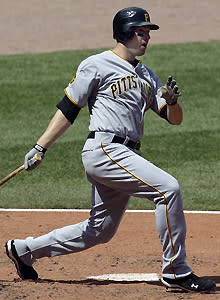Juiced baseballs are a tightly wound myth

The juiced ball is baseball's version of the Loch Ness Monster, a creature so fantastical that you want to believe it's real. Like Nessie, there is no way to prove the existence of Juicy – the magical baseball that Major League Baseball orders wound extra-tight to promote more home runs – so we have to wait for a conspiracy theorist to emerge from the woods every few years and claim it's back.
After the home run frenzy opening weekend left baseball looking for answers – because the truth, small-sample-size fluctuation, doesn't exactly satisfy most appetites – there came our savior, an unnamed bullpen catcher, who told the Atlanta Journal-Constitution's Dave O'Brien that balls feel harder this year and, he believes, that's not an accident.
The economy is bad, the catcher's thinking went, and home runs drive excitement. So of course the next logical step is racketeering. In order to juice balls, MLB would need cooperation among the cork makers in Mississippi, the yarn spinners in Vermont and the hide sewers in Costa Rica, plus those who test the balls in St. Louis, and the final layers of quality control, the clubhouse attendants who rub them with mud and the umpires who keep a bagful at a time.
Perhaps, still, the catcher was on to something. Surely not all of baseball could be in on the conspiracy, least of all the men it would embarrass most, the pitchers who cringe at giving up any home runs. One simple question could solve the mystery: Is the ball you threw the first weekend different in any way?
"Same ball," said Royals starter Jeff Francis(notes), who has yielded three homers.
"Nothing different," said Royals starter Bruce Chen(notes), victim of three as well.
"I didn't give up any homers," White Sox starter Mark Buehrle(notes) said. "Nope. Balls are pretty fine with me."
"I gave one up," said his teammate, John Danks(notes). "But it wasn't the ball."
Four pitchers. Same answer. No juiced ball. MLB even issued a statement confirming as much.
Damn.
It would've been fun to go through the silliness of 2000 all over again, when so many people inside baseball were convinced that MLB was juicing the ball, the league actually commissioned a study comparing that year's ball with those from the year before. The results were stunning: The balls were the same! Same weight. Same circumference. Negligible difference in how far they flew. A lab in Massachusetts had fired them out of cannons, literally, to find some distinction. It couldn't.
Something else was juiced, of course, and it's funny to look back at the naïveté of just a decade ago. The idea of 2.34 home runs per game still boggles the mind – particularly considering through this season's first 46 games, when the home run tumult was reaching Brobdingnagian proportions, there were 2.35 per game.
Because they came in bunches – Texas hit 11 off Boston and the Los Angeles Angels-Kansas City series featured 15 over four games – the antennae rose and assigned a question: WHY!, in capital letters and with an exclamation point, since so much in baseball does come with an explanation.
Had this surge happened in, say, August, when the weather is warmer and the ball flies farther, nobody would've thought a thing. Because last year was the supposed Year of the Pitcher, though, and because it's easy to ignore things like the size of Texas' ballpark [small] and the wind at Kauffman Stadium over the weekend [big], and because, let's be honest, we all enjoy a good buzzing by black helicopters, the juiced ball, bless its sweet heart, returned for one of its small hurrahs.
"People search for an explanation when funny things happen," Francis said. "The thing is, we play this game so much, funny things are bound to happen."
Few understand the potential of a loaded baseball like Francis. He spent the first six years of his career in Colorado, where the Rockies in 2002 started storing game-used balls in a humidor. For nearly a decade, pitchers had complained the balls were too hard, too slick, too difficult to grip. The humidor mitigated those issues, and offensive numbers have dropped since then. Compared to the balls still used in Rockies batting practice, Francis said, those placed in the humidor feel significantly closer to ones in stadiums at lower altitudes.
It doesn't deter the paranoia. Last fall, in the middle of a pennant race, San Francisco Giants starter Tim Lincecum(notes) caught a ball from an umpire and started to fiddle with it. He spun it in his right hand a few times before tossing it back to the ump. A TV camera caught him mouthing a reaction with a perplexed look on his face: "Truckin' juiced ball bullspit." Or something like that.
Lincecum beat the Rockies that night, prompting shortstop Troy Tulowitzki(notes) to tell him: "Good game. We couldn't even get you with our juiced balls."
The ball may or may not have gone in the humidor. It may or may not have been juiced. Like Lincecum said, "If it's happening or not, it doesn't really matter." The legend of the juiced ball lives on, even if an increasing sample has brought us closer to reality.
On Monday, there were 11 home runs in six games, and on Tuesday, 17 in 14, for a total of 136 in 66 games. That brought the home run rate back to 2.06 per game – much closer to the 1.90 in the Year of the Pitcher than the 2.35 in the Year of the Steroid.
"If I give up a couple home runs my next start, come back to me then," Buehrle said. "I bet the balls will be juiced."
